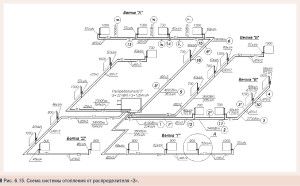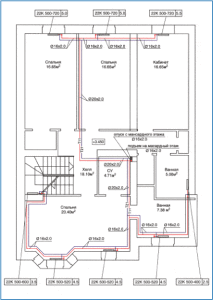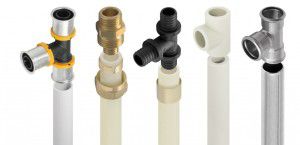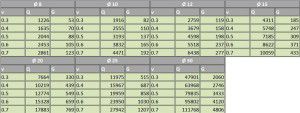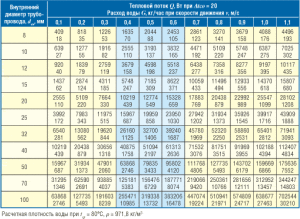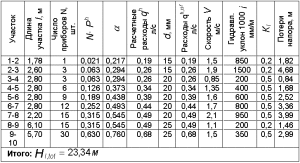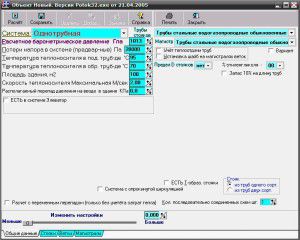For the efficient operation of the heating system, it is necessary to fulfill several conditions - choose the right components and make a calculation. From the correct calculation of the system parameters, its efficiency and uniform heat distribution depend. How to make a hydraulic calculation of a heating system - examples, programs will help you perform these calculations.
Purpose of hydraulic calculation of heating
During the operation of any heat supply system, hydraulic resistance inevitably arises when the heat carrier moves. To account for this parameter, a hydraulic calculation of a two-pipe heating system is required. Its essence lies in the correct selection of system components, taking into account their operational qualities.
In fact, the hydraulic calculation of water heating systems is a complex procedure, during which all the subtleties and nuances are taken into account. At the first stage, it is necessary to determine the required heating capacity, select the optimal piping layout, as well as the thermal mode of operation. Based on these data, a hydraulic calculation of the heating system is done in Excel or a specialized program. The result of the calculations should be the following parameters of water heat supply:
- Optimum pipe diameter. Based on this, you can find out their throughput, heat loss. Given the choice of material of manufacture, the resistance of the water to the inner surface of the line will be known;
- Pressure and pressure loss in certain areas of the system. An example of a hydraulic calculation of a heating system will allow you to think in advance of mechanisms for their compensation;
- Water consumption;
- Required pumping power. Actual for closed systems with forced circulation.
At first glance, the hydraulic resistance of the heating system is complicated. However, it’s enough to get a little deeper into the essence of the calculations and then you can do them yourself.
To heat a small house or apartment, it is also recommended to calculate the hydraulic resistance of the heating system.
The procedure for calculating the hydraulic parameters of heating
At the first stage of calculating the parameters of the heating system, a preliminary diagram should be drawn up, which indicates the location of all components. Thus, the total length of the mains is determined, the number of radiators, the volume of water, as well as the characteristics of the heating appliances are calculated.
How to make a hydraulic calculation of heating without experience in such calculations? It should be remembered that for autonomous heat supply it is important to choose the diameter of the pipes correctly. It is from this stage that the calculations should begin.
It is best to make a heating scheme on an already prepared plan of the house. This will allow you to correctly calculate the consumption of material and determine its quantity for the arrangement of the system.
Determining the optimum pipe diameter
The most simplified hydraulic calculation of the heating system includes only the calculation of the cross section of the pipelines. Often when designing small systems, they do without it. To do this, take the following parameters of the pipe diameters depending on the type of heat supply:
- Open circuit with gravity circulation. Pipes with a diameter from 30 to 40 mm. Such a larger cross section is necessary to reduce losses due to friction of water on the inner surface of highways;
- Closed system with forced circulation. The cross section of the pipelines varies from 8 to 24 mm. The smaller it is, the greater the pressure will be in the system and, accordingly, the total volume of the coolant will decrease. But at the same time, hydraulic losses will increase.
If there is a specialized program for the hydraulic calculation of the heating system, it is enough to fill in the data on the technical characteristics of the boiler and transfer the heating circuit. The software package will determine the optimal pipe diameter.
The received data can be checked independently. The procedure for performing hydraulic calculation of a two-pipe heating system manually when calculating the diameter of the pipelines is to calculate the following parameters:
- V - water velocity. It should be in the range from 0.3 to 0.6 m / s. Determined by the performance of pumping equipment;
- Q - heat flow. This is the ratio of the amount of heat passing over a certain period of time - 1 second;
- G - water consumption. It is measured in kg / hour. Directly depends on the diameter of the pipeline.
In the future, to perform the hydraulic calculation of water heating systems, you need to find out the total volume of the heated room - m³. Assume that this value for one room is 50 m³. Knowing the power of the heating boiler (24 kW), we calculate the final heat flow:
Q = 50/24 = 2.083 kW
Then, to select the optimal pipe diameter, you need to use the table data compiled when performing hydraulic calculation of the heating system in Excel.
In this case, the optimal internal diameter of the pipe in a particular section of the system is 10 mm.
In the future, to perform an example of hydraulic calculation of the heating system, you can find out the estimated water flow, which will whistle from the diameter of the pipe.
Manufacturers of polymer pipes indicate the outer diameter. Therefore, for the correct calculation of the hydraulic resistance of the heating system, two wall thicknesses of the mains should be taken away.
Accounting for local resistance in the highway
An equally important step is the calculation of the hydraulic resistance of the heating system in each section of the highway. For this, the entire heat supply scheme is conditionally divided into several zones. It is best to do the calculations for each room in the house.
The following values will be needed as initial data for entering into the program for hydraulic calculation of the heating system:
- The length of the pipe in the area, mp;
- The diameter of the line. The calculation procedure is described above;
- Required coolant speed. It also depends on the diameter of the pipe and the power of the circulation pump;
- Reference data specific to each type of manufacturing material - coefficient of friction (λ), friction loss (ΔР);
- The density of water at a temperature of + 80 ° C will be 971.8 kg / m³.
Knowing these data, you can make a simplified hydraulic calculation of the heating system. The result of such calculations can be seen in the table.
When carrying out this work, it must be remembered that the smaller the selected heating area, the more accurate will be the data of the general system parameters. Since it will be difficult to make a hydraulic calculation of heat supply from the first try, it is recommended to carry out a series of calculations for a certain interval of the pipeline. It is desirable that there should be as few additional devices as possible - radiators, valves, etc.
To check the hydraulic calculation of a two-pipe heating system, you need to perform it in several different programs or additionally manually by yourself.
Overview of Hydraulic Computing Software
In fact, any hydraulic calculation of water heat supply systems is a complex engineering task.To solve it, a number of software systems have been developed that simplify the implementation of this procedure.
You can try to make a hydraulic calculation of the heating system in the Excel shell, using ready-made formulas. But at the same time, the following problems may occur:
- Big error. In most cases, one-pipe or two-pipe schemes are taken as an example of a hydraulic calculation of a heating system. Finding similar calculations for collector is problematic;
- To correctly account for the hydraulic resistance of the pipeline, reference data are needed that are not in the form. They need to be searched and entered additionally.
Given these factors, experts recommend using programs for calculation. Most of them are paid, but some have a demo with disabilities.
Oventrop CO
The simplest and most understandable program for hydraulic calculation of a heat supply system. The intuitive interface and flexible configuration will help you quickly understand the nuances of data entry. Small problems may arise during the initial setup of the complex. It will be necessary to enter all the parameters of the system, starting from the material of pipe manufacturing and ending with the location of the heating elements.
HERZ C.O.
It is characterized by the flexibility of settings, the ability to make a simplified hydraulic calculation of heating for both the new heating system and the modernization of the old one. It differs from analogues in a convenient graphical interface.
Instal-Therm HCR
The software package is designed for professional hydraulic resistance of the heat supply system. The free version has many limitations. A scope - design of heating in large public and industrial buildings.
In practice, for the autonomous heat supply of private houses and apartments, hydraulic calculation is not always performed. However, this can lead to a deterioration in the operation of the heating system and the rapid failure of its elements - radiators, pipes and boiler. To avoid this, you need to calculate the system parameters in a timely manner and compare them with the actual ones to further optimize the heating operation.
An example of a hydraulic calculation of a heating system:
